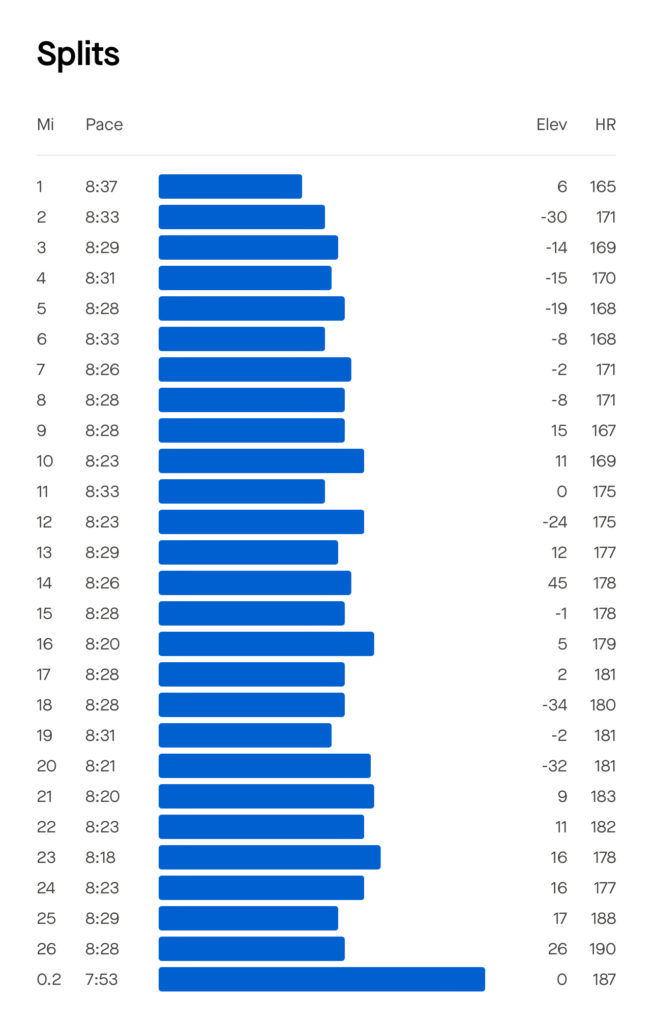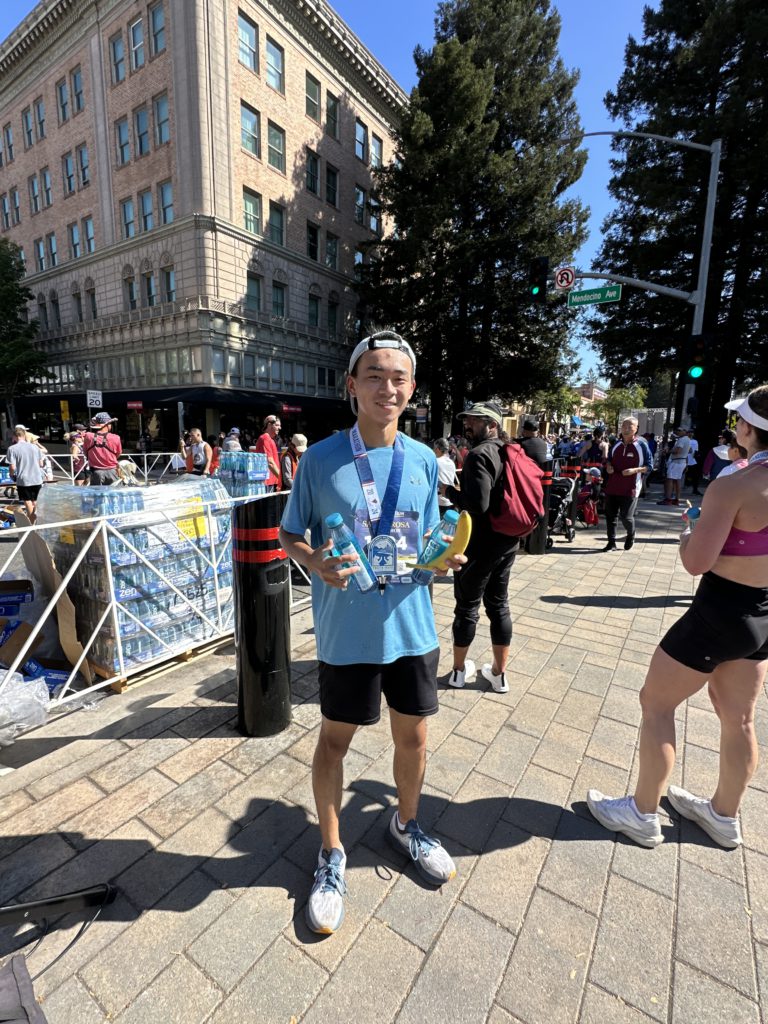Running My 1st Marathon

Photo: 30 minutes before my first marathon
Part 1: Pre-Race
If you told me one year ago that I would be running a marathon, I would’ve scoffed at you. “No way I can run 26.2 miles (42.2 kilometers). I don’t have the endurance for that. You gotta be kidding me. Running marathons are only limited to the elite few.” I would watch marathon videos from my favorite runners Kofuzi or Floris Gierman and be in awe of them at this incredible feat.
While I initially pushed away the thought of running a marathon, the seed was already planted in my mind. And as I deepened my obsession with this sport, the idea of actually running one became more and more feasible. As 2024 approached, I turned my eyes toward the goal: running the 2024 Los Angeles Marathon, March 17th. It was time to lock in.
Training flew by. I was knocking down miles like a machine. 30-mile weeks became 40-mile weeks. As February approached, with one month of training left, I hit my first-ever 50-mile week. But after a series of back-to-back 10-mile runs, something felt off. The top of my left knee began quivering, and I immediately knew something was off. No, f*cking way.
Setback
During my first peak training week, I injured myself, forcing me to terminate all efforts. The desire to run my first marathon was stronger than ever, but I couldn’t push anymore to risk further injury. Shit. Shit. Shit. That set me back to square one. All my fitness that I had accumulated in 4 months had gone to waste. Just like that. I was at an all-time physical and mental time low.
The morning of the supposed race day, I watched the news in my dorm room as thousands of runners began their race at Dodgers Stadium. I felt defeated, but I knew I couldn’t let a single obstacle stop me from accomplishing my goal. I had to honor not only my New Year’s Resolution but my own promise – that I would do everything in my power to finish a marathon. I journaled that day.
“It’s such a bummer since I literally woke up to the marathon Instagram page posting start line stories and posts, and here I am, stuck in bed, because of a stupid injury that should’ve never happened in the first place. Once this injury is all done and healed, I’m going to try harder than anyone has ever seen. I’m GOING to run a marathon this year, no matter what. I committed to it in my New Year’s Resolution, and I’m not going to back out of it. Just one setback. I’m coming for you.” – March 17th, 2024

Photo: Post-rainy run doing my LA Marathon training block
New Start
I stopped training for 2 months to let my injury heal. When April rolled around, my knee finally felt good enough for me to slowly begin running again. However, as much as I was glad to get back into it, my fitness was nonexistent, and it infuriated me how out of shape I had gotten. Any cardiovascular sport must be consistently maintained; if not, you go back to zero.
However, I stayed determined to the goal of getting back to my prime and stuck to the process. I started running 10 miles per week, till 25 miles became the norm. I was slightly getting better, but the lack of good progress kept me incredibly doubtful that I would be in any way near the level of fitness required to finish a marathon. But all I could do was continue hammering in the miles.
By the time I finished my 1st year of university and headed back home for the summer, I had an open 1.5 months of training to seriously lock in. I had my eyes set on the 2024 San Francisco Marathon on July 28th. Training was going well back home, and I was soon at the level of my prime fitness back in the beginning of February. But a new problem came up…
My family wanted to head on a trip, and the dates completely coincided with race day. No, no, no… I couldn’t say no to this trip (family mattered way more than a measly New Year’s Resolution), but at the same time, I couldn’t let all my fitness slide back down. I frantically searched all over the Internet, seeing if there was another race I could sign up for. Then, a miracle presented itself:
Santa Rosa Marathon, August 25th, 2024. This was the one. Not only would I be able to extend my training block an extra month, but this was a much faster race course than the hilly San Francisco one. Bingo. It was time to dial the f*ck in and take my fitness into uncharted territory – to a level that surpassed all my previous expectations.
Backstory
Back in elementary and middle school, I’d consider myself somewhat of a fast runner. For three consecutive years, I won my elementary school’s annual fundraiser running event (run as many laps in 30 minutes), and I had a mile time PR of 6:36 min/mi. But as I stopped running completely afterward, I found myself physically dying after running a 8:30 min/mi during the pandemic.
When I got back into running, doing consistent 5ks at ~8:30 min/mi paces, I found myself stuck at a plateau. No matter how consistently I ran them, I couldn’t improve my endurance or my pace – I would be absolutely gassed after finishing the 3.1 miles. Something had to change, and that was when I discovered the power of low heart rate running.
The biggest mistake a majority of runners make is running too fast. And paradoxically enough, running slow is the only way to run faster and longer over time. I found myself dialing my paces back to a butt-slow 11:30 min/mi pace, and anytime my heart rate would spike above a certain threshold, I would have to either walk or slow down.
Frustrating as that was many times, my pace did eventually improve over the many months of consistent training. As I’m writing this, 36 hours before my race day, my easy pace has improved over 2 minutes, at ~9:10 min/mi. Running 5ks at ~8:30 mi/mi is a walk in the park. In fact, this former 5k pace is now my goal marathon pace, from 3.1 miles to 26.2 miles…
Countdown
I don’t know how I got here, less than 36 hours from the start line to the marathon. But all I know is the amount of dedication I have put into this process. I have run at least 5 days a week (except one) for 17 weeks straight, with 13 straight weeks of running at least 30-40 miles. Factor in all the walking I did, and you get a string of 40-50-mile weeks.
There were runs that tested my ability as an athlete. Speed workouts that pushed my limits. Abnormal heat conditions throughout July that made me sweat buckets after every run. But the long runs I did upward of 20 miles gave me the confidence booster I needed to run this marathon. And that’s all I need. Clear signs of evidence that I can, indeed, finish a marathon.
But I intend not only to finish a marathon – I intend to race it. And I have set myself the somewhat lofty goal of finishing it below 3:45, averaging a pace faster than 8:30 min/mi. The ultimate goal, though, is a sub-3-hour marathon. It sounds impossible at the moment – you literally have to run 26 straight miles under 6:50 min/mi pace – but in the future, I know it will be more than feasible.
So here it is, my entire 17-week training plan for the 2024 Santa Rosa Marathon. I have done everything I could’ve done to prepare for this moment. All that is left is the race itself. In fact, the hardest part about marathons isn’t the marathon itself; it’s the culmination of all the preparation you have to do in order to run a good marathon. To me, the marathon is simply the victory lap.
It’s time. Time to lock tf in. 26.2 miles, 42.2 kilometers. One of if not the greatest sporting event since the time of Ancient Greece. Legs feeling fresh after taper. Mentally feeling sharp as a hawk hunting for its prey. Physically feeling fitter than ever. Time to elevate to a new level, to run through the beautiful wineries of Santa Rosa.
Time to create some art. 🤍
Part 2: Post-Race
Running a marathon is one of those experiences where you look back and wonder: How the hell did I actually do it? 24 hours after the race, life returns back to normal, and the only tangible indicator that you did, in fact, run a marathon is the soreness you feel all over your legs. But like many surreal experiences you have in life, you end up looking back at it as if it was only one second.
I ended up achieving my goal of a sub-3:45. In fact, I smashed it by 3 minutes and 31 seconds. Official time: 3:41:29. To run 26.2 miles in a row is a superhuman act. When you perform something so out of the ordinary that breaks the confines of human perception, you end up in disbelief, and that’s exactly how I felt. Because less than a year ago, I never thought running a marathon was even possible.

Photo: Mile splits for the marathon (8:28 min/mi average)
The Race
Those who don’t run marathons believe you have to suffer through the entirety of the 26.2 miles to complete it. But from my experience, it’s really only the last 10k where things do get really difficult – where you truly have to suffer. The first 20 miles of the race were genuinely really enjoyable, and you get a feeling of aliveness that you can’t really get anywhere else.
One of the most special moments of a marathon is the buildup of anticipation 5, 10 minutes before the race begins. Everyone is eagerly waiting, the national anthem is played, and the countdown begins. There is an air of excitement amongst the crowd. You feel so f*cking ready, and any second now, you’ll be taking off, beginning this grandiose adventure of running 26.2 miles.
When the race starts, the hardest challenge is not shooting off too fast. I was aiming for a sub-3:45, so I did my very best to stay within 8:35 min/mi pace, slowly easing into it. The first few miles feel like you’re literally flying. You know you can run much faster, but you considerably hold back to conserve energy for the later, more difficult, parts of the race.
In addition to pacing, nutrition and hydration are key factors in a successful performance. I came into the race with 6 GU gels – 3 strawberry lemonade and 3 tri-berry. I took my first gel exactly an hour into the race (at 7 miles), followed by increments of 4 miles: at miles 11, 15, 19, and 23. Throughout the course, water and electrolyte stations were relatively frequent, at every 1.5 miles.
When you’re running a marathon, you constantly have to monitor your pace. If you’re struggling by the halfway mark (13.1 miles), you’re in trouble. A marathon is a perpetual balance between: should I slow down, should I speed up, or should I maintain? I felt surprisingly good at miles 18-20, so I continued pressing on, opting for a negative split (when the second half is faster than the first).
In the world of marathoning, people often say: “Mile 20 is when the real race begins.” That is true. By the last 10k, many fall back, unable to maintain their previous pace, simply due to sheer exhaustion. But those who persevere and dig deep until the very end will finish strong and quite possibly achieve that well-deserved negative split. I went for the latter, and it paid off.
But kid you not, miles 22-25 was extremely hard. Like everyone else, I was in a deep pain cave, and I struggled quite a bit. But because of the conservative pacing I held for the first 20 miles, I was able to maintain the same pace – and even run a few seconds faster – to push through the dark place. But those who make out of it, into the final 0.2 miles, will see the light at its fullest glory.
The last leg of the marathon is an experience like no other. You’re totally depleted, but you give it with everything you’ve got to carry your exhausted body to the finish line. Passing the finish line feels like a moment of liberation. You’re all done. You’re all f*cking done. Your body may be completely fried, but you’ve completed a superhuman feat that very few do in their lifetimes.

Photo: Post marathon
Newsletter
Enjoyed this essay? Consider subscribing to my newsletter below, where I share weekly wisdom for the artistic and personal updates.
